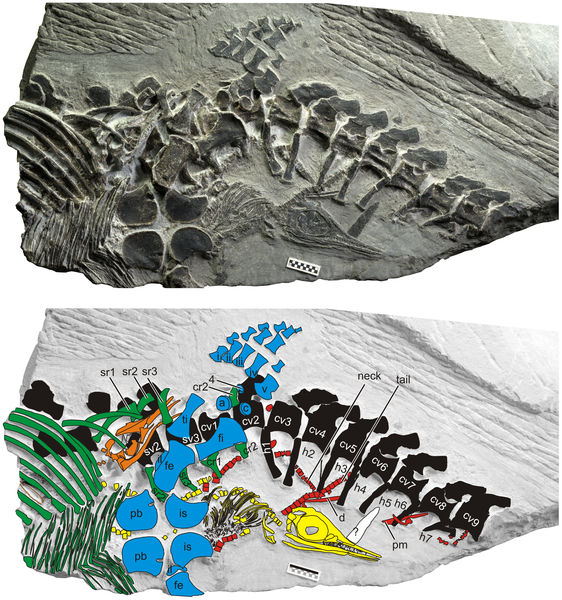Vivipary, the development of an embryo inside the mother’s uterus and eventually leading to live birth, has for marine reptiles traditionally been considered to have developed in the aquatic environment. However, a new open access paper published February 12th 2014 in PLOS One by Motani et al. 2014: “Terrestrial Origin of Viviparity in Mesozoic Marine Reptiles Indicated by Early Triassic Embryonic Fossils” provides evidence that the oldest known marine reptiles belonging to the genus Chaohusaurus (Reptilia, Ichthyopterygia) gave birth to their young through head-first birth posture, in contrast to younger (and more derived) ichtyosaurs who gave birth tail-first, just like modern whales.
Chaohusaurus, the oldest known genus of the Ichtyopterygia, inhabited the oceans during the Early Triassic, som 248 million years ago. Motani et al. 2014 found 80 new fossil skeletons of Chaohusaurus in a quarry in China. One of the specimens shows the partial skeleton of a female Chaohusaurus with three embryos, of which one is in birth position. The beautiful and exceptional fossil is pictured below, but I highly recommend reading the original paper and viewing its high resolution figures!

Figure 2 in Motani et al. 2014. The maternal specimen with three embryos.
Color coding indicates: black, maternal vertebral column, including neural and haemal spines; blue, maternal pelvis and hind flipper; green, maternal ribs and gastralia. Embryos 1 and 2 are in orange and yellow, respectively, whereas neonate 1 is in red. Scale bar is 1 cm. Abbreviations: i-v, metatarsals; 4, fourth distal tarsal; a, astragalus; c, calcaneum; cr, caudal rib; cv, caudal vertebra; d, dentary; fe, femur; fi, fibula; h, haemal spine; il, ilium; is, ischium; pb, pubis; pm, premaxilla; sr, sacral rib; sv, sacral vertebra; and ti, tibia. doi:10.1371/journal.pone.0088640.g002
The authors argue that because one of the Chaohusaurus-babies (1) lies outside the maternal body in the present specimen, this suggests that the mother had already given birth to at least one offspring before it died. They conclude that the mother likely died in labor, and because the rock containing the fossil is marine, birth most likely occurred underwater. Because the skull orientation of the embryos is head-first this suggests that viviparity in Ichthyopterygia most likely evolved in an ancestor on land, where head-first position during birth is the norm.
The authors conclude that both marine reptiles belonging to Ichthyopterygia and also Sauropterygia most likely evolved from viviparous land ancestors in the Early Triassic, at least as early as 248 million years ago. Therefore, viviparity may have already been common among terrestrial reptiles during the recovery phase from the end-Permian mass extinction.
